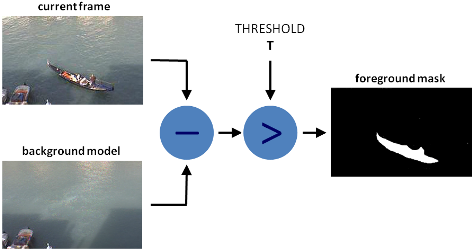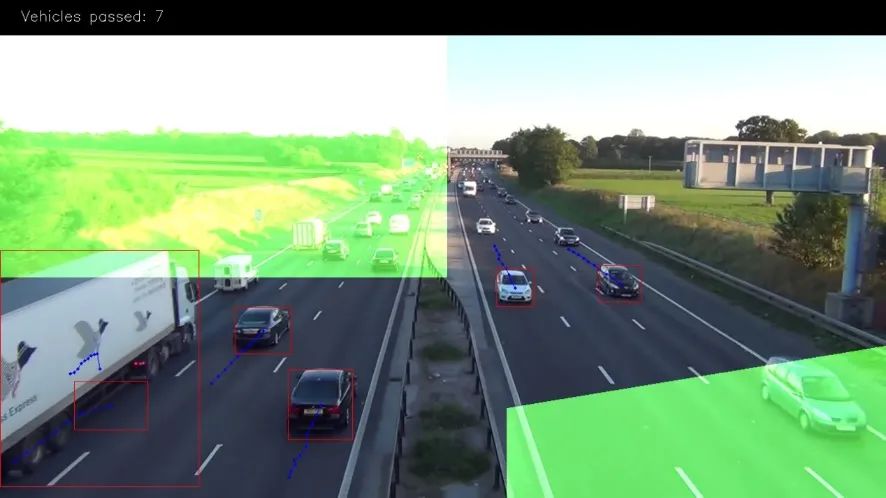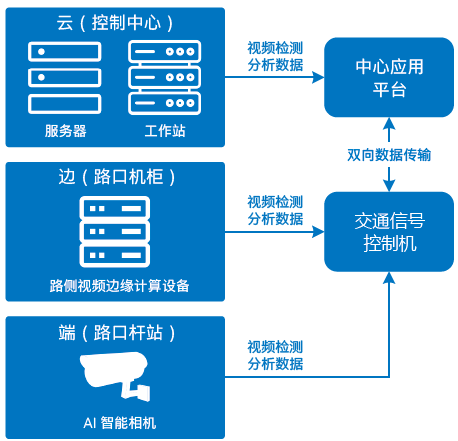今天,我们将一起探讨如何基于计算机视觉实现道路交通计数。
在本教程中,我们将仅使用Python和OpenCV,并借助背景减除算法非常简单地进行运动检测。
我们将从以下四个方面进行介绍:
1. 用于物体检测的背景减法算法主要思想。
2. OpenCV图像过滤器。
3. 利用轮廓检测物体。
4. 建立进一步数据处理的结构。
背景扣除算法

有许多不同的背景扣除算法,但是它们的主要思想都很简单。
假设有一个房间的视频,在某些帧上没有人和宠物,那么此时的视频基本为静态的,我们将其称为背景(background_layer)。因此要获取在视频上移动的对象,我们只需要:用当前帧减去背景即可。
由于光照变化,人为移动物体,或者始终存在移动的人和宠物,我们将无法获得静态帧。在这种情况下,我们从视频中选出一些图像帧,如果绝大多数图像帧中都具有某个相同的像素点,则此将像素作为background_layer中的一部分。
我们将使用MOG算法进行背景扣除

原始帧
代码如下所示:
import os import logging import logging.handlers import random import numpy as np import skvideo.io import cv2 import matplotlib.pyplot as plt import utils # without this some strange errors happen cv2.ocl.setUseOpenCL(False) random.seed(123) # ============================================================================ IMAGE_DIR = "./out" VIDEO_SOURCE = "input.mp4" SHAPE = (720, 1280) # HxW # ============================================================================ def train_bg_subtractor(inst, cap, num=500): ''' BG substractor need process some amount of frames to start giving result ''' print ('Training BG Subtractor...') i = 0 for frame in cap: inst.apply(frame, None, 0.001) i += 1 if i >= num: return cap def main(): log = logging.getLogger("main") # creting MOG bg subtractor with 500 frames in cache # and shadow detction bg_subtractor = cv2.createBackgroundSubtractorMOG2( history=500, detectShadows=True) # Set up image source # You can use also CV2, for some reason it not working for me cap = skvideo.io.vreader(VIDEO_SOURCE) # skipping 500 frames to train bg subtractor train_bg_subtractor(bg_subtractor, cap, num=500) frame_number = -1 for frame in cap: if not frame.any(): log.error("Frame capture failed, stopping...") break frame_number += 1 utils.save_frame(frame, "./out/frame_%04d.png" % frame_number) fg_mask = bg_subtractor.apply(frame, None, 0.001) utils.save_frame(frame, "./out/fg_mask_%04d.png" % frame_number) # ============================================================================ if __name__ == "__main__": log = utils.init_logging() if not os.path.exists(IMAGE_DIR): log.debug("Creating image directory `%s`...", IMAGE_DIR) os.makedirs(IMAGE_DIR) main()
处理后得到下面的前景图像

去除背景后的前景图像
我们可以看出前景图像上有一些噪音,可以通过标准滤波技术可以将其消除。
滤波
针对我们现在的情况,我们将需要以下滤波函数:Threshold、Erode、Dilate、Opening、Closing。
首先,我们使用“Closing”来移除区域中的间隙,然后使用“Opening”来移除个别独立的像素点,然后使用“Dilate”进行扩张以使对象变粗。代码如下:
def filter_mask(img): kernel = cv2.getStructuringElement(cv2.MORPH_ELLIPSE, (2, 2)) # Fill any small holes closing = cv2.morphologyEx(img, cv2.MORPH_CLOSE, kernel) # Remove noise opening = cv2.morphologyEx(closing, cv2.MORPH_OPEN, kernel) # Dilate to merge adjacent blobs dilation = cv2.dilate(opening, kernel, iterations=2) # threshold th = dilation[dilation < 240] = 0 return th
处理后的前景如下:

利用轮廓进行物体检测
我们将使用cv2.findContours函数对轮廓进行检测。我们在使用的时候可以选择的参数为:
cv2.CV_RETR_EXTERNAL------仅获取外部轮廓。
cv2.CV_CHAIN_APPROX_TC89_L1------使用Teh-Chin链逼近算法(更快)
代码如下:
def get_centroid(x, y, w, h):
x1 = int(w / 2)
y1 = int(h / 2)
cx = x + x1
cy = y + y1
return (cx, cy)
def detect_vehicles(fg_mask, min_contour_width=35, min_contour_height=35):
matches = []
# finding external contours
im, contours, hierarchy = cv2.findContours(
fg_mask, cv2.RETR_EXTERNAL, cv2.CHAIN_APPROX_TC89_L1)
# filtering by with, height
for (i, contour) in enumerate(contours):
(x, y, w, h) = cv2.boundingRect(contour)
contour_valid = (w >= min_contour_width) and (
h >= min_contour_height)
if not contour_valid:
continue
# getting center of the bounding box
centroid = get_centroid(x, y, w, h)
matches.append(((x, y, w, h), centroid))
return matches
建立数据处理框架
我们都知道在ML和CV中,没有一个算法可以处理所有问题。即使存在这种算法,我们也不会使用它,因为它很难大规模有效。例如几年前Netflix公司用300万美元的奖金悬赏最佳电影推荐算法。有一个团队完成这个任务,但是他们的推荐算法无法大规模运行,因此其实对公司毫无用处。但是,Netflix公司仍奖励了他们100万美元。
接下来我们来建立解决当前问题的框架,这样可以使数据的处理更加方便
class PipelineRunner(object):
'''
Very simple pipline.
Just run passed processors in order with passing context from one to
another.
You can also set log level for processors.
'''
def __init__(self, pipeline=None, log_level=logging.DEBUG):
self.pipeline = pipeline or []
self.context = {}
self.log = logging.getLogger(self.__class__.__name__)
self.log.setLevel(log_level)
self.log_level = log_level
self.set_log_level()
def set_context(self, data):
self.context = data
def add(self, processor):
if not isinstance(processor, PipelineProcessor):
raise Exception(
'Processor should be an isinstance of PipelineProcessor.')
processor.log.setLevel(self.log_level)
self.pipeline.append(processor)
def remove(self, name):
for i, p in enumerate(self.pipeline):
if p.__class__.__name__ == name:
del self.pipeline[i]
return True
return False
def set_log_level(self):
for p in self.pipeline:
p.log.setLevel(self.log_level)
def run(self):
for p in self.pipeline:
self.context = p(self.context)
self.log.debug("Frame #%d processed.", self.context['frame_number'])
return self.context
class PipelineProcessor(object):
'''
Base class for processors.
'''
def __init__(self):
self.log = logging.getLogger(self.__class__.__name__)
首先我们获取一张处理器运行顺序的列表,让每个处理器完成一部分工作,在案顺序完成执行以获得最终结果。
我们首先创建轮廓检测处理器。轮廓检测处理器只需将前面的背景扣除,滤波和轮廓检测部分合并在一起即可,代码如下所示:
class ContourDetection(PipelineProcessor):
'''
Detecting moving objects.
Purpose of this processor is to subtrac background, get moving objects
and detect them with a cv2.findContours method, and then filter off-by
width and height.
bg_subtractor - background subtractor isinstance.
min_contour_width - min bounding rectangle width.
min_contour_height - min bounding rectangle height.
save_image - if True will save detected objects mask to file.
image_dir - where to save images(must exist).
'''
def __init__(self, bg_subtractor, min_contour_width=35, min_contour_height=35, save_image=False, image_dir='images'):
super(ContourDetection, self).__init__()
self.bg_subtractor = bg_subtractor
self.min_contour_width = min_contour_width
self.min_contour_height = min_contour_height
self.save_image = save_image
self.image_dir = image_dir
def filter_mask(self, img, a=None):
'''
This filters are hand-picked just based on visual tests
'''
kernel = cv2.getStructuringElement(cv2.MORPH_ELLIPSE, (2, 2))
# Fill any small holes
closing = cv2.morphologyEx(img, cv2.MORPH_CLOSE, kernel)
# Remove noise
opening = cv2.morphologyEx(closing, cv2.MORPH_OPEN, kernel)
# Dilate to merge adjacent blobs
dilation = cv2.dilate(opening, kernel, iterations=2)
return dilation
def detect_vehicles(self, fg_mask, context):
matches = []
# finding external contours
im2, contours, hierarchy = cv2.findContours(
fg_mask, cv2.RETR_EXTERNAL, cv2.CHAIN_APPROX_TC89_L1)
for (i, contour) in enumerate(contours):
(x, y, w, h) = cv2.boundingRect(contour)
contour_valid = (w >= self.min_contour_width) and (
h >= self.min_contour_height)
if not contour_valid:
continue
centroid = utils.get_centroid(x, y, w, h)
matches.append(((x, y, w, h), centroid))
return matches
def __call__(self, context):
frame = context['frame'].copy()
frame_number = context['frame_number']
fg_mask = self.bg_subtractor.apply(frame, None, 0.001)
# just thresholding values
fg_mask[fg_mask < 240] = 0
fg_mask = self.filter_mask(fg_mask, frame_number)
if self.save_image:
utils.save_frame(fg_mask, self.image_dir +
"/mask_%04d.png" % frame_number, flip=False)
context['objects'] = self.detect_vehicles(fg_mask, context)
context['fg_mask'] = fg_mask
return contex
现在,让我们创建一个处理器,该处理器将找出不同的帧上检测到的相同对象,创建路径,并对到达出口区域的车辆进行计数。代码如下所示:
'''
Counting vehicles that entered in exit zone.
Purpose of this class based on detected object and local cache create
objects pathes and count that entered in exit zone defined by exit masks.
exit_masks - list of the exit masks.
path_size - max number of points in a path.
max_dst - max distance between two points.
'''
def __init__(self, exit_masks=[], path_size=10, max_dst=30, x_weight=1.0, y_weight=1.0):
super(VehicleCounter, self).__init__()
self.exit_masks = exit_masks
self.vehicle_count = 0
self.path_size = path_size
self.pathes = []
self.max_dst = max_dst
self.x_weight = x_weight
self.y_weight = y_weight
def check_exit(self, point):
for exit_mask in self.exit_masks:
try:
if exit_mask[point[1]][point[0]] == 255:
return True
except:
return True
return False
def __call__(self, context):
objects = context['objects']
context['exit_masks'] = self.exit_masks
context['pathes'] = self.pathes
context['vehicle_count'] = self.vehicle_count
if not objects:
return context
points = np.array(objects)[:, 0:2]
points = points.tolist()
# add new points if pathes is empty
if not self.pathes:
for match in points:
self.pathes.append([match])
else:
# link new points with old pathes based on minimum distance between
# points
new_pathes = []
for path in self.pathes:
_min = 999999
_match = None
for p in points:
if len(path) == 1:
# distance from last point to current
d = utils.distance(p[0], path[-1][0])
else:
# based on 2 prev points predict next point and calculate
# distance from predicted next point to current
xn = 2 * path[-1][0][0] - path[-2][0][0]
yn = 2 * path[-1][0][1] - path[-2][0][1]
d = utils.distance(
p[0], (xn, yn),
x_weight=self.x_weight,
y_weight=self.y_weight
)
if d < _min:
_min = d
_match = p
if _match and _min <= self.max_dst:
points.remove(_match)
path.append(_match)
new_pathes.append(path)
# do not drop path if current frame has no matches
if _match is None:
new_pathes.append(path)
self.pathes = new_pathes
# add new pathes
if len(points):
for p in points:
# do not add points that already should be counted
if self.check_exit(p[1]):
continue
self.pathes.append([p])
# save only last N points in path
for i, _ in enumerate(self.pathes):
self.pathes[i] = self.pathes[i][self.path_size * -1:]
# count vehicles and drop counted pathes:
new_pathes = []
for i, path in enumerate(self.pathes):
d = path[-2:]
if (
# need at list two points to count
len(d) >= 2 and
# prev point not in exit zone
not self.check_exit(d[0][1]) and
# current point in exit zone
self.check_exit(d[1][1]) and
# path len is bigger then min
self.path_size <= len(path)
):
self.vehicle_count += 1
else:
# prevent linking with path that already in exit zone
add = True
for p in path:
if self.check_exit(p[1]):
add = False
break
if add:
new_pathes.append(path)
self.pathes = new_pathes
context['pathes'] = self.pathes
context['objects'] = objects
context['vehicle_count'] = self.vehicle_count
self.log.debug('#VEHICLES FOUND: %s' % self.vehicle_count)
return context
上面的代码有点复杂,因此让我们一个部分一个部分的介绍一下。

上面的图像中绿色的部分是出口区域。我们在这里对车辆进行计数,只有当车辆移动的长度超过3个点我们才进行计算
我们使用掩码来解决这个问题,因为它比使用矢量算法有效且简单得多。只需使用“二进制和”即可选出车辆区域中点。设置方式如下:
EXIT_PTS = np.array([
[[732, 720], [732, 590], [1280, 500], [1280, 720]],
[[0, 400], [645, 400], [645, 0], [0, 0]]
])
base = np.zeros(SHAPE + (3,), dtype='uint8')
exit_mask = cv2.fillPoly(base, EXIT_PTS, (255, 255, 255))[:, :, 0]
现在我们将检测到的点链接起来。
对于第一帧图像,我们将所有点均添加为新路径。
接下来,如果len(path)== 1,我们在新检测到的对象中找到与每条路径最后一点距离最近的对象。
如果len(path)> 1,则使用路径中的最后两个点,即在同一条线上预测新点,并找到该点与当前点之间的最小距离。
具有最小距离的点将添加到当前路径的末端并从列表中删除。如果在此之后还剩下一些点,我们会将其添加为新路径。这个过程中我们还会限制路径中的点数。
new_pathes = []
for path in self.pathes:
_min = 999999
_match = None
for p in points:
if len(path) == 1:
# distance from last point to current
d = utils.distance(p[0], path[-1][0])
else:
# based on 2 prev points predict next point and calculate
# distance from predicted next point to current
xn = 2 * path[-1][0][0] - path[-2][0][0]
yn = 2 * path[-1][0][1] - path[-2][0][1]
d = utils.distance(
p[0], (xn, yn),
x_weight=self.x_weight,
y_weight=self.y_weight
)
if d < _min:
_min = d
_match = p
if _match and _min <= self.max_dst:
points.remove(_match)
path.append(_match)
new_pathes.append(path)
# do not drop path if current frame has no matches
if _match is None:
new_pathes.append(path)
self.pathes = new_pathes
# add new pathes
if len(points):
for p in points:
# do not add points that already should be counted
if self.check_exit(p[1]):
continue
self.pathes.append([p])
# save only last N points in path
for i, _ in enumerate(self.pathes):
self.pathes[i] = self.pathes[i][self.path_size * -1:]
现在,我们将尝试计算进入出口区域的车辆。为此,我们需获取路径中的最后2个点,并检查len(path)是否应大于限制。
# count vehicles and drop counted pathes:
new_pathes = []
for i, path in enumerate(self.pathes):
d = path[-2:]
if (
# need at list two points to count
len(d) >= 2 and
# prev point not in exit zone
not self.check_exit(d[0][1]) and
# current point in exit zone
self.check_exit(d[1][1]) and
# path len is bigger then min
self.path_size <= len(path)
):
self.vehicle_count += 1
else:
# prevent linking with path that already in exit zone
add = True
for p in path:
if self.check_exit(p[1]):
add = False
break
if add:
new_pathes.append(path)
self.pathes = new_pathes
context['pathes'] = self.pathes
context['objects'] = objects
context['vehicle_count'] = self.vehicle_count
self.log.debug('#VEHICLES FOUND: %s' % self.vehicle_count)
return context
最后两个处理器是CSV编写器,用于创建报告CSV文件,以及用于调试和精美图片的可视化。
class CsvWriter(PipelineProcessor):
def __init__(self, path, name, start_time=0, fps=15):
super(CsvWriter, self).__init__()
self.fp = open(os.path.join(path, name), 'w')
self.writer = csv.DictWriter(self.fp, fieldnames=['time', 'vehicles'])
self.writer.writeheader()
self.start_time = start_time
self.fps = fps
self.path = path
self.name = name
self.prev = None
def __call__(self, context):
frame_number = context['frame_number']
count = _count = context['vehicle_count']
if self.prev:
_count = count - self.prev
time = ((self.start_time + int(frame_number / self.fps)) * 100
+ int(100.0 / self.fps) * (frame_number % self.fps))
self.writer.writerow({'time': time, 'vehicles': _count})
self.prev = count
return context
class Visualizer(PipelineProcessor):
def __init__(self, save_image=True, image_dir='images'):
super(Visualizer, self).__init__()
self.save_image = save_image
self.image_dir = image_dir
def check_exit(self, point, exit_masks=[]):
for exit_mask in exit_masks:
if exit_mask[point[1]][point[0]] == 255:
return True
return False
def draw_pathes(self, img, pathes):
if not img.any():
return
for i, path in enumerate(pathes):
path = np.array(path)[:, 1].tolist()
for point in path:
cv2.circle(img, point, 2, CAR_COLOURS[0], -1)
cv2.polylines(img, [np.int32(path)], False, CAR_COLOURS[0], 1)
return img
def draw_boxes(self, img, pathes, exit_masks=[]):
for (i, match) in enumerate(pathes):
contour, centroid = match[-1][:2]
if self.check_exit(centroid, exit_masks):
continue
x, y, w, h = contour
cv2.rectangle(img, (x, y), (x + w - 1, y + h - 1),
BOUNDING_BOX_COLOUR, 1)
cv2.circle(img, centroid, 2, CENTROID_COLOUR, -1)
return img
def draw_ui(self, img, vehicle_count, exit_masks=[]):
# this just add green mask with opacity to the image
for exit_mask in exit_masks:
_img = np.zeros(img.shape, img.dtype)
_img[:, :] = EXIT_COLOR
mask = cv2.bitwise_and(_img, _img, mask=exit_mask)
cv2.addWeighted(mask, 1, img, 1, 0, img)
# drawing top block with counts
cv2.rectangle(img, (0, 0), (img.shape[1], 50), (0, 0, 0), cv2.FILLED)
cv2.putText(img, ("Vehicles passed: {total} ".format(total=vehicle_count)), (30, 30),
cv2.FONT_HERSHEY_SIMPLEX, 0.7, (255, 255, 255), 1)
return img
def __call__(self, context):
frame = context['frame'].copy()
frame_number = context['frame_number']
pathes = context['pathes']
exit_masks = context['exit_masks']
vehicle_count = context['vehicle_count']
frame = self.draw_ui(frame, vehicle_count, exit_masks)
frame = self.draw_pathes(frame, pathes)
frame = self.draw_boxes(frame, pathes, exit_masks)
utils.save_frame(frame, self.image_dir +
"/processed_%04d.png" % frame_number)
return context
结论
正如我们看到的那样,它并不像许多人想象的那么难。但是,如果小伙伴运行脚本,小伙伴会发现此解决方案并不理想,存在前景对象存在重叠的问题,并且它也没有按类型对车辆进行分类。但是,当相机有较好位置,例如位于道路正上方时,该算法具有很好的准确性。
责任编辑:彭菁
-
过滤器
+关注
关注
1文章
427浏览量
19550 -
计算机视觉
+关注
关注
8文章
1696浏览量
45925 -
OpenCV
+关注
关注
30文章
626浏览量
41250
原文标题:使用OpenCV实现道路车辆计数
文章出处:【微信号:vision263com,微信公众号:新机器视觉】欢迎添加关注!文章转载请注明出处。
发布评论请先 登录
相关推荐
关于基于英特尔AI计算机视觉的边缘计算设备





 如何基于计算机视觉实现道路交通计数
如何基于计算机视觉实现道路交通计数













评论